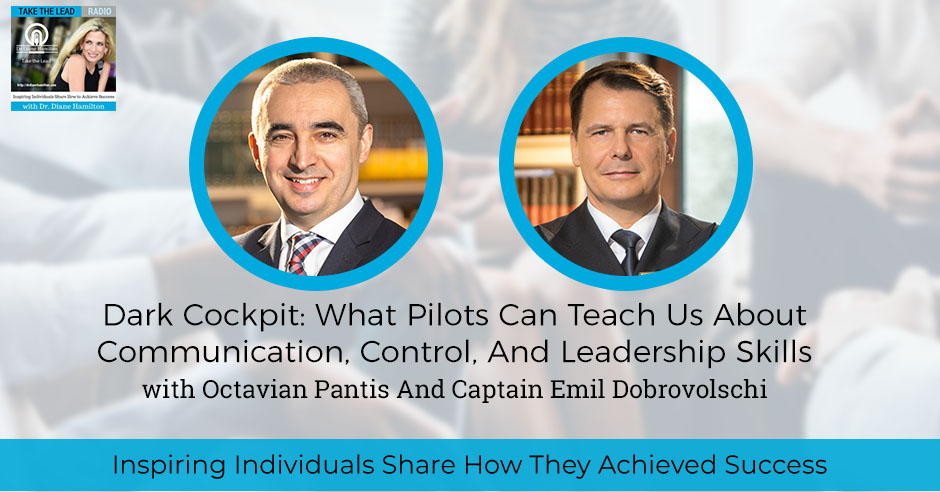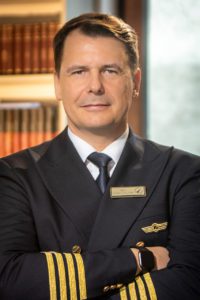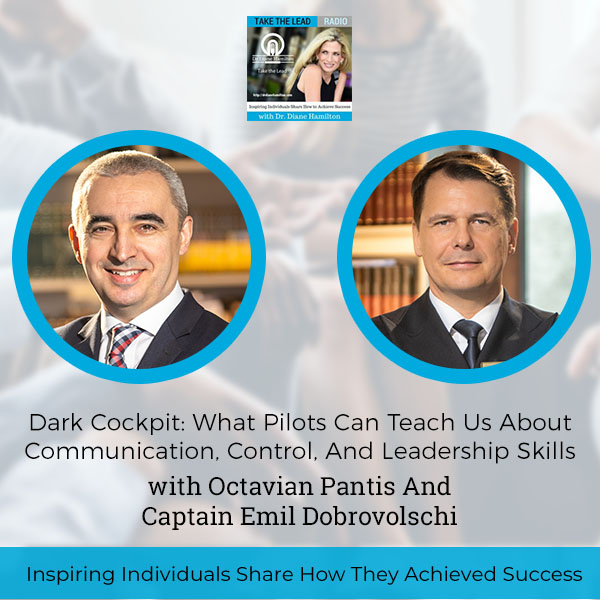Are you interested in learning leadership skills from the view of a captain? Join your host, Dr. Diane Hamilton, as she interviews our guests about team effectiveness and productivity. Octavian Pantis is an entrepreneur, and the Co-Founder and Managing Partner of Qualians, an international training and consulting company, dedicated to helping organizations thrive while providing an environment where people grow professionally and are deeply engaged. Qualian’s is a leadership development company, and they work with organizations large and small international organizations to help them develop the human side of business performance skills, productivity skills. They help companies have a stronger and healthier culture that attracts talent. Captain Emil Dobrovolschi is a pilot, a pilot instructor, and a pilot examiner presenting to people how to realize a project in a safe environment, respecting the procedures and telling them how to deal with leadership challenges and the different scenarios of emergencies. Dive deep into this episode and learn about leadership, resilience, communication, and team effectiveness!

I am so glad you joined us because we have Octavian Pantis and Captain Emil Dobrovolschi. They are co-authors of a book entitled Dark Cockpit, which is an aviation concept for when everything is good, there are no lights going on, and there is nothing you have to worry about. I love the reference to all the aviation aspects of the book. These two are very interesting. We were going to talk about a lot of things that are going to deal with leadership, resilience, communication, team effectiveness, and so much more.
—
Watch the episode here
Listen to the podcast here
Dark Cockpit: What Pilots Can Teach Us About Communication, Control, And Leadership Skills With Octavian Pantis And Captain Emil Dobrovolschi
I am here with Octavian Pantis and Captain Emil Dobrovolschi, co-authors of Dark Cockpit, a new book I am very excited to hear about. That is an expression from aviation and I cannot wait to hear about that. I am going to introduce you to them and have them give their backstory. Welcome, gentlemen.
Diane, it is great to be with you. Thank you for the invitation.
Thank you, Diane, for the invitation.
You are welcome. I am looking forward to hearing about this. I had not heard that expression, but I’m not in aviation. I have taught at an aviation school, so this would have been fun when I was there, but I could still share it with my students in that realm. I think they’ll find that interesting. I want to get a backstory on each of you. Let’s start with Octavian. I know your company Qualians and others that you deal with. I want to hear a little bit about what you do in addition to writing the book and what led to your interest in this.

Dark Cockpit: How to Communicate, Lead, and Be in Control at All Times Like an Airline Captain
I have three hats. One is I am an entrepreneur. Our company, Qualians, is a leadership development company and we work with large and small international organizations to help them develop what we call the human side of business performance, leadership skills, productivity skills, and help their company have a stronger and healthier culture that attracts and keeps talent to engage. That is one hat.
Related to that is my second hat, which is I am a speaker. I am often invited to management sessions, but also to large audiences. My third hat is I am an author. I wrote my first book several years ago on productivity and work-life balance. I wrote four more audiobooks on different subjects and I am very glad to be a co-author with Captain Emil Dobrovolschi on our new book Dark Cockpit.
I got some questions for you on that, but I will hold on to get a little background from Captain Emil.
I am Emil Dobrovolschi. I am the Captain with Romanian National Carrier, TAROM, for many years. I am a professional pilot since ’92. I have experiences as a co-pilot and then I became Captain on ATRs. I became an instructor and Type Rating Examiner with TAROM. I flew lots of aircraft in TAROM fleets like Airbus A320 and Airbus A310.
For three years, I have been the Vice President of the company and the Flight Operation Manager. Besides my vast experience as a pilot, instructor, and examiner for several years, I am a speaker speaking in front of different audiences. Not about aviation but telling people what the treasure is in the knowledge of doing things properly in presenting your product. My product is flight, so I am presenting to people how to realize a project in a safe environment, respecting the procedures and telling them how to deal with leadership challenges and different scenarios of emergency situations.
You both have very interesting backgrounds in the pilot aspect. I had the last passenger off of Sully’s flight on my show in the past. That was quite a story. It is always interesting to me to hear everybody’s passions of what they do, from having an interest in the human side of business to having this experience in the flight and a captain side of things.
You two came together to write an interesting book and you are discussing leadership, resilience of team effectiveness, and so many things. Ethics which I find personally interesting, just because I have taught so many ethics classes. We will start with leadership because that is such a broad topic. I know that you were talking about being co-pilot to captain and different things. I do not know if you want to start, Emil, or I will let you guys decide who wants to answer, but you say there are three broad requirements if you want to go from co-pilot to captain. I want to know what they are.
[bctt tweet=”Leadership is the hardest to teach somebody because it involves their attitude.” via=”no”]In terms of the physical distances to step from the right-hand seat in an aircraft cockpit to the left, it is maybe three feet distance, but there is a huge gap between those seats because the things are required for a good pilot are a good level of their knowledge about the aircraft systems, manuals and aerodynamics.
The second one is to have a good level of their skill meaning to handle the aircraft and know where to stop the checklist. Airmanship is also a skill. The last one is the hardest to teach somebody. It is leadership, attitude, how to communicate, make a decision, build a decision and present to the team every day as a different team or as a leader, not just as a boss or manager of the flight. This is the most important thing we teach our co-pilots to become captain. These are the subjects and topics we are mostly discussing in our training and recurrent checks.
It is fascinating to use these analogies of different ways to look at how you can get from one spot to another. It is only three feet and one way of measuring it is always a whole other situation when you look at what you go through in the working world. A lot of us are going through this COVID issue. I thought it was interesting that you wrote about resilience as well. I have seen more people having to just be resilient in a time where they are down. How did you hit on resilience in the book? We can go to Octavian or you guys could decide to answer. How do you think COVID has impacted this time and how are we to get our resilience up?
COVID has impacted all of us clearly in different ways. When we talk about resilience, many things do not work. With COVID, there are many things that do not work as they did in the past. What we say is focus on what does work. First, if you are an entrepreneur, you have a company, and your business is down. Do you still have some clients? Yes.
Focus on them. Make sure that they are happy. Make sure you do everything you can to keep them happy. See if you can ask for a referral from them so you can move from there. Do you still have a team? We still have a team. Work with that team to identify ways in which you can help customers and identify new services, which you can offer. Resilience is very much about looking at what works. If eight things do not work, let’s focus on the other two and build from them.
I think that people often get very concerned as they start to lose customers and are not looking at what they have. Sometimes, if we work harder in what we have, we can have better sales than if we try to spread ourselves too thin. I teach this a lot in a lot of my courses. Another thing you guys wrote about that I thought was important is you touched a lot on communication and interpersonal skills.
I wrote my dissertation on emotional intelligence, which covers a lot of that and interpersonal skills are a big part of that. It was fun having Daniel Goleman on the show and we talked a lot about the value of emotional intelligence. There are a lot of misunderstandings in the business world. A lot of people do not communicate well. I imagine that it is pretty scary for pilots if they do not communicate well. If you are not communicating well in any company situation or if you have poor interpersonal skills, it is a big problem. In your analogy, how do pilots communicate?
I want to ask your previous question about resilience because the pilots are in an unfriendly environment. As soon as they are taking off, they are in a metal tube with wings and taking off with 140 knots, flying over the mountains through the clouds. Anytime, the machine can go wrong with something in the systems of the aircraft.
These kinds of activities build something in the crew operating the aircraft. The story goes when we go to the simulator for the recurrent training. We have one of the most complex cases. It’s dual hydraulic. The aircraft has three hydraulic systems in it. Two of them are completing each other.
When there are two hydraulic systems down, we have a dual hydraulic failure. It is a very complex and very sophisticated checklist to go through. You announce mayday, which is an emergency call, so everybody expects you to land quickly. We have a word in aviation. We have to land as soon as possible. You do not have to crash as soon as possible.

Leadership Skills: Practicing is good, preparing in a safe environment and being tested by peers with tough questions. We should be doing more of that in business because that will help us get better meetings, results, and partnerships.
This case, especially this one, requires about 35 to 45 minutes to prepare the aircraft for landing. Imagine an aircraft in the air announcing mayday and holding for another half an hour to figure out how to land, choose the proper runway, and choose the proper configuration for landing. Every time I have the pilots in the simulator, my students are concerned about this one because it is a very complex, long and sophisticated checklist.
Every time I ask them, “Can you control the aircraft?” “Yes, we can control it.” You can bank, pitch, and control the engines. The engines are working properly. Can you make it cold in the aircraft or can we cool it down? Can you heat it a little bit? Yes. Can you drink a coffee? If you have the time to drink the coffee.
If you look at it like this, it is a little bit sluggish in handling. You need time to prepare. Did the autopilot does not work? Maybe the automation does not work properly, but still, you can control the aircraft. Looking from this perspective, you always see the foot part of the glass, isn’t it? It is not like thinking, “I lost two hydraulic systems. I am in trouble. I have to do this. It is very sluggish. I cannot control it.” If you think like this in the aircraft, it is not good for your flight.
[bctt tweet=”Expect the unexpected and be prepared for it a step ahead.” via=”no”]I am just interested in the flying aspect for a minute more than the leadership, because this is so fascinating to me. Are there no wind scenarios in any of those simulations? Do you think that saved Sully from doing those simulations and what does that carry over into your business?
In a full flight simulator, if the session is conducted properly by the instructor, the pilots, in about 5 to 10 minutes, will think they are in a real aircraft because all they see, hear, feel and all the vibrations are exactly like in real life. We have lessons that are standardized and each stage has a different syllabus. I had cases when I had to stop the session because there were too shocked by what they went through. Some of the exercises are kept for the last part of the session because it is so much consumption of physiological and psychological resources from the pilots that you keep those part of the sessions to be the last ones.
Otherwise, if you put them first, they are very consuming. In terms of communication in the business world and everyday life, people go, “We did communicate well every time something goes wrong. We could communicate better. It was a miscommunication situation.” I have a word that aviation history was written in blood and the importance of communication is paramount.
For us, it is a matter of life and death. To pass a message in a busy environment, dark cockpit, or dark environment, not looking to each other to validate with your eyes, the movement or the body language or the other one is very difficult. It is a skill. Every time, I tell my pilots in the briefing room before the simulator that I appreciate them as expert communicators. Not just once they were happy to hear that, but I had to explain more to tell them that to pass a message without a doubt to each other, control the air traffic controller, or give a command to the flight crew or flight attendants, that is a skill they develop in time.
When you refer to the dark cockpit, do you mean there are no lights on other than your ambient instrument lighting. There are no warning lights, caution lights, and there is nothing. Are you saying that we do not get these warnings and we have to know when we’re in turbulent times? I will ask Octavian. What meaning do you have behind that?
Researching for the book together with Emil for a few years was fascinating to find out so many interesting things about aviation. If I may have a comment on the simulators, I think one thing that businesses are missing is the equivalent of the full flight simulator. Every pilot, twice a year for 2 times, 4-hour each, they are in the simulator. They have to be there.
The first four hours they are being trained, and the second four-hour slot they are being examined. If they get a good score, they get to continue to fly. If the score is not good enough, they are stopped from flying. What do they do? They practice and practice again. They do not think this takes something away from their authority if they are seen to be practicing, but in businesses, the higher you go, the more people tend to think, “I am good enough. I do not need to practice for this negotiation or meeting.”
Practicing is good. Preparing in a safe environment and being tested by peers with tough questions. We should be doing more of that in business because that will help us get better meetings, results and partnerships. When coming to the expression Dark Cockpit, when we wrote the book, we did not start with the title.
We said, “Let’s focus on the content. Let’s focus on providing value for the reader, and we’ll worry about the title towards the end.” There were two titles on the shortlist. One was, This Is Your Captain Speaking which we thought was nice because it sets the scene. It is the aviation thing, but we did not go for that because we did not want to come across as aggressive in a way or looking people downwards to say, “You shut up now because we are going to tell you what to do.” We didn’t want that. We went with the other one, which is Dark Cockpit. Dark Cockpit is an expression from aviation, which is a good expression. It means everything is fine and you could hear the Captain, “How was your flight from Paris to whatever?” “It was fine. It was dark cockpit all the way.”
What does it mean? It means that in the cockpit, there was no other light on outside those ambient lights and everything because whenever there is a light on, you have to do something. The worst situation is the red light, which is a warning signal. There is the continuous alarm, which means something bad. For instance, an engine on fire or something malfunctioning. You can have caution lights, which are amber in color and there is just one being.

Leadership Skills: When we wrote the book, we did not start with the title. We focused on the content and providing value for the reader, and we’ll worry about the title towards the end.
It means that something has happened. You do not necessarily need to do something about it now, but just know that this particular system is not working as it should. You then can have blue lights, which is a system that usually is off. You set it to on for defrosting the aircraft. I need it to be on because it is freezing outside, but that consumes resources from the plane. You can have some other lights too.
Whenever this happens, it means it is more stressful or bad things are more likely to happen. Dark cockpit is everything smooth, and we said, “That is what we want for the reader.” Whatever the reader is doing, they are piloting their own professional career, a team or an organization. We want them to fly in dark cockpit. The whole book is about what can you do to prevent those lights from coming on to make sure that you do your best, you prevent, and you are in control all the time. That is what the title comes from.
As I looked through the book on the different chapters, you guys touch on so many things. I know, Octavian, you speak like I do and talk about things like motivation and engagement. I tie it with my work on curiosity and getting people out of status-quo thinking, and one of the guests I had on my show was Amy Edmondson, who’s a Harvard Professor and was great in TED Talk.
She does a lot of talks talking about teams versus teaming in her presentation at TED. In your book, you have something you call a new crew every day, which you refer to as the fact that every flight has a new team, basically. That ties into what she and I talked about because with her talk. She was saying it is all about collaboration and that requires curiosity. What do you think we all need to help us perform well as a team?
One of the fascinating things in aviation is that the captain gets to fly with a certain co-pilot once every couple of months in a midsize company. One of the large companies like the big American ones might be a year or more until you fly again with the same co-pilot. Sometimes you say, ” I am Octavian. We are going to fly together.”
You still have to exercise team skills and leadership skills. Of course, they know you, the one who has four stripes on their shoulder is the captain and the co-pilot has three. How do you do that? Being curious and what Emil does very well is that in the meeting before the flight, he makes sure to ask something of everyone, whether it is something like, “When does your medical license expire,” or something else about the role.” He wants to interact with every single one of them in that briefing space.
Another thing that you must do in business is showing up prepared. You cannot afford not to be prepared and to find out things as you go. Another thing that Captain Emil likes to do is to show up in the briefing room 10 to 15 minutes earlier so that by the time everyone else is there, they do not discover the weather maps together, but he already knows it, and they do not discover what else is there, but he comes prepared.
What can we do to be better team players or team leaders? We need to understand that our success is given by the performance of everyone in that team. The more we know about them, the more we get to trust them. The more we share about ourselves, the easier it will be for them to trust us too. That is number one. Number two is to be prepared. Number three is making sure your first impression is good. Number four is to pay attention to the smallest things as well.
If somebody does something inappropriate, maybe not saying hello to passengers, if you do not do or do not say anything to notice that, then sooner or later people will do worse things and it is late for you to intervene then. The moment you see something is not right, say something about that and make sure that people acknowledge it and fix it right away because the last thing you need when you are on a flight or in a business meeting is to hope to fix everything there.
There is a lot of work before that. This is a temptation. The more experienced business people are, the more they tend to rely or they are like, “I am good. It is not my first rodeo.” We need to prepare. The more we prepare, the easier it is. The same is true in sports. The more you prepare before the Olympics, the easier it is. It is never super easy because it is the Olympics or a fight. The more prepared you are, the easier it is when it matters most.
[bctt tweet=”Leaders should know how to communicate or build their decision to present to the teams.” via=”no”]I am glad you brought up being prepared because I have had a lot of crisis preparation experts on the show. I had them on even before this COVID situation. There is a time that we have needed to be more prepared. I am curious about what aviation does to prevent accidents. I remember taking a class once where they said the last person to impact the airplane was the guy closing the hatch on the luggage doors. I am looking out with those guys now going, “Are you okay?” How can we prepare for all issues? Do you worry about those guys out there? You are inside the cockpit.
Let me just say one short thing and I will hand it over to Emil. We should become best friends with the question, “What if?” What can go wrong? What if this happens? What if that happens? The more time we spend thinking about these possibilities, the better it will be for us.
I love the questioning aspect from curiosity standpoint. Emil, I’d like to get your perspective about crisis preparation and what you have to do to be prepared. We’re all in crisis, and I am sure you have a lot to worry about in aviation. The last guy to impact the plane is the guy closing the door outside on the luggage rack. Do you worry about your team? How do you prepare for a crisis if you do not have complete control over things all the time?
First of all, all the professionals around me are very well-trained and checked periodically. It is recurrent training for each person, which is allowed to operate or to be close to an aircraft. This is a high level of professionalism for each person. Secondly, I have thresholds for each stage of my flight. Together with my crew and co-captain I am flying within the cockpit. I have different thresholds from the moment we are moving out of the gate, starting the engines, and taxing for takeoff, each stage of the takeoff, each part of the climb, and the crews.
It is very funny because you can see us. If you have a camera in the cockpit, maybe we can chat. We chat having a coffee, but our eyes at 39,000 feet are scanning the instruments all the time. In each captain’s mind is, “Where am I at right now? What is on my left? Was the minimum sector altitude on the right? If I am losing one engine, which will be the escape route or my aircraft?” All the time in the background, your brain goes like this. Even that you can see us in the cockpit if you are invited. Unfortunately, it is not allowed these days.
If you were in a cockpit with us, you could see us chatting and the pilots are listening to all the time with the frequency. They are scanning the instruments and they are preparing for the worst because outside, it is minus 70 degrees Celsius and the wind blows with 1,000 kilometers per hour. It is an unfriendly environment. If you have one engine loss and you have over the mountains, you need a plan.
The first part is to have different thresholds for alert and secondly, to have a plan for each unexpected surprise. We have an alert always. That is why you are tired after the flight. Not because you chat in the cockpit at 39,000 feet with your friend. You are tired because you are looking all the time for something which can go wrong and you are prepared for it because if you are the person behind all of my passengers, they do not care if you are tired or not, or if you have a happy life. They paid the ticket and expect you to perform and fly them from A to B in a safe, comfortable manner and in time if possible.
Our entire training is based on looking for unexpected surprises and you have a long checklist for it. Even though it is a normal flight, we perform checklist after checklist, maybe six times the same checklist. As professionals, we look for each detail in each small space between one flight to another because there are no two flights the same. There is no project like before.
If I am taking off 3, 4, or 6 times a day, each takeoff and each flight is different. Even though I am coming to the same airport, there’ll be different neurological conditions. Maybe the aircraft has some faults or some defects I have to deal with. This alert, as a professional, I can advise any manager to expect the unexpected and be prepared for it a step ahead, anticipate, and fly ahead of the aircraft with your mind with 80 miles.
There are so many examples of companies who ran into so many issues in the past. Even if you are looking at the captain’s role, you’ve got to deal with the Boeing planes or the ducks flying into your engine kinds of things. Have you ever had anything scary happened to you as a captain?
Define scare. I have a flight and it was extreme weather. I had to avoid it with my radar a lot. I am always looking for the safe side of the flight, but also, I am thinking about my passengers. There are maybe children, women, or people normally who do not like flying. It is an unfriendly environment for everybody. Imagine this is for somebody who is scared of flight. Sometimes, the flight can be scary in a turbulent condition, isn’t it?
It is got to be scary for people when they are duct-taping people to chairs and things. I have never seen anything like that.
Happily, that happens very rarely that there is severe turbulence. May I add one thing on the expression of aviation? Try to be ten minutes ahead of your plane to be a little more proactive rather than reactive. What does it mean in business? For instance, I have a habit that whenever I receive an application from someone, a CV or somebody writes me on LinkedIn, “I am interested to work as a consultant or as something.”
Even if we are fine as a team for the projects that we handle, I make time to carefully read what they write, look at their profile, give them a call, maybe even meet some of them for coffee, because you never know when you might need someone else in your team. It might be a new project coming up or somebody that you rely on, they might take a leave or something.
I make a habit of always meeting with everyone or at least getting in touch with everyone who writes us about, “Can we work together sometimes?” I spent 5, 10, or 30 minutes to know that they are at hand, and if the time comes, we do not have to invest and start from zero, but decide on a few people that I can call and who can help us.
It is important that we network and we get to know people. As a pilot examiner, I am interested, Emil, that you do that and talk about getting to know somebody. You have to examine everything they do. What does that entail and what can we learn from that?

Leadership Skills: We need to have high standards, and we need to maintain them. If we lead a team, one of the best things we can do is to make sure that everyone in our team, whatever industry or department, leaves at these high standards.
At the beginning, I was very concerned about me being an examiner and I have been an examiner for many years. First in ATR Aircraft, then Airbus A310 and Airbus A320 because it is a great responsibility. You have a female or a male captain in front of you and you have to hire them in your company. We have to make sure that they are not just complying the rules and they are not just following the procedures, we have to be sure that they are able to operate the aircraft in a secure and safely manner.
We have lots of procedures and syllabus for it. At the end of the day, the question is, “Am I confident that that person in front of me in the simulator trying to perform their best are able to fly with my family, with my children and my wife?” I consider them able to do this, so I will pass them. This is the question the examiner has on his mind all the time.
Also, in an organization, when you are an instructor or when you go somewhere to examine people, it is a great responsibility, but also, it is very hard to fail someone because they are of different ages. Maybe they didn’t perform well for whatever reason, but if the end of the day, if they are in front of you, if they didn’t perform well to fly with your family, you never allow them to fly again. To grounding them, I failed people all the time based on the syllabus or having in mind this question all the time.
It is interesting because I was a pharmaceutical rep for a long time and one thing I noticed is you think that doctors know everything, but you got to realize somebody did graduate at the bottom of their class. I imagine the same thing with pilots. Do you ever get on a plane and go, “This was the guy that just barely passed.”
This is one of the reasons behind my decision always to judge somebody’s performance based on not just realistic expectations but based on the safety standard. My colleagues, the professionals in aviation, have a high standard because the lowest mark they get to pass is 7.5 out of 10. There was no mediocre performance pilot in aviation because they have to be at least 7.5 out of 10. It is a high standard.
It is fun to watch some of the flying things. I have watched Kaley Cuoco’s show. They push it to make it seem a lot more wild than it probably is. Could any of these Denzel Washington things happen that you see in the movies?
Actually no. Theoretically, airliners can fly backward, but the engines are fed gravitationally and fed by pumps. No, an aircraft will never fly upside down. Dynamically speaking, it can flip up and you can do a looping if you want.
You must have fun watching the movies that deal with airplanes and the crazy stuff they have like Air Force One. I think we learn a lot from analogies to different kinds of jobs. I get a lot of former professionals and they have a lot of sports analogies, but it helps paint a picture, having worked in sales forever, speaking, and all the stuff I do. People like to see something painted differently. I could see that this book would be appealing in that respect as well. I wanted to see if there is anything I didn’t ask you guys that you want to make sure people know about your book. Octavian, is there something that you’d like to add at all?
If anybody wants to find out more about our book, they can download and read the free chapter if they go to the webpage DarkCockpitbook.com. If they want to buy the book, we’ll be happy. They can find the book on Amazon, Barnes & Noble and all the important platforms. We can send them signed copies.
If I were to summarize a little bit, what can we learn as people from business in large or small companies that in aviation, before the COVID crisis hit, the peak was in June 2019. I think there were around 250,000 commercial flights in a day. That is a lot of flights. Many things must go well and very well for that to happen. Communication between tower, the people in the cockpits, the booking systems and everything.
The message for us is we need to have high standards and we need to maintain them. If we lead a team, one of the best things we can do is to make sure that everyone in our team, whatever industry or department you are in, lives at this high standard. It is more work, but it is less stressful because you know that you’ve done your homework, you are doing well, and customers will be happy.
[bctt tweet=”You have to prepare and know how to adjust if things don’t work properly.” via=”no”]At the end of the day, no matter how tired you are, you know you did your best and that is a good feeling, which you cannot compare to anything. Aviation is a world of high standards, and there is a treasure of know-how on communication, leading and being in control. What we did with the book, what we try to do and from the feedback that we have now is that we achieved it.
It is not a collection of interesting or fascinating stories about aviation and then Denzel Washington or Tom Hanks or somebody else will play some of them. It is not a boring book about causes for accidents. It has some stories, some principles and many bridges to people who want to achieve more.
We have had the book bought by leaders for their team, businesses for their customers, parents for their teenage or older kids, or people for their parents who are maybe afraid to fly. Read this and when you see many things that need to take place, you’ll be more confident to fly. We would be happy to hear from any of our readers what they thought of the book. You can easily find us on LinkedIn. That is the easiest place for anybody to find us, Octavia Pantis and Emil Dobrovolschi. Feel free to write us. If anybody has questions, we’ll be glad to answer them right away.
Chris Hemsworth is playing you, Emil, in the movie about your life?
Yes. Every time I laugh with Octavian about it, my personal ambition is that the Dark Cockpit to become a meme as The Black Swan is now because The Black Swan, Nassim Taleb’s book, is now well known in the business. Everybody is talking about The Black Swan when something unexpected happens and changing the world in one day. My ambition is for Dark Cockpit to become one of those memes in business and everybody’s life. When your life goes in a dark cockpit means that everything is okay.
I hope that your book does it well. This was fun. I think that a lot of people can check out your site. Thank you so much for being such great guests.
Thank you, Diane. Congratulations on your work and for everything you do. It was a pleasure to talk to you. All the best to everybody who is reading.
Thank you, Diane.
You are welcome.
—
I’d like to thank Emil and Octavian for being my guests. We get so many great guests on this show, and sometimes we talk about them on the show like Amy Edmondson and Daniel Goleman, and all the people we mentioned on the show. There are places where we have tweetable moments. If you find something that you find fascinating, I’d love to have you guys tweet something that is stood out to you. There is a lot of great content on the site.
In addition to the show, if you go to DrDianeHamilton.com, you can get to the Curiosity Code Index or the Perception Power Index if you are interested in taking either of those assessments. The books Cracking the Curiosity Code and The Power of Perception are both linked to that as well. If you are a consultant and you are interested in becoming certified to give the Curiosity Code Index or the Perception Power Index, that is there as well. You would get five hours of SHRM Recertification Credit, which is great to keep up with the certification at SHRM.
We’re getting so much information about how much the research I did on curiosity is impacting the world. I was honored to be nominated as 1 of the top 10 Thought Leaders in HR leadership space by peopleHum and I thought that was nice of them to pick me for that honor. The other nine are just unbelievable people, and some of them have been on my show.
I just thought you might want to check that out as well. There is a lot of that stuff about nominations, awards and things because being part of Thinkers50 radar and all that has been a real honor. I put a lot of that on my media page. If you are on my site, please check the dropdown menus at the top and as well as the bottom. There are more testimonials and information at the bottom that a lot of guests from the show have left amazing comments.
It is fun just to go to the about me page because if you go there, you could see a lot of guests from the show. If they are in town, I will take pictures with them and it scrolls across at the bottom, and it from everybody from Steve Forbes to Ken Fisher and people who I have interviewed, who are fascinating and we have been able to meet in person, I have put pictures on the bottom there. It is fun to see who all I have got to meet so far. Even though with Emil and Octavian, we haven’t met yet, but in the future, I hope to meet all the guests from the show. There is just so much content that every show ties into the value of curiosity and asking questions.
As we were talking about teams and teaming with Amy Edmondson and how it helped with collaboration, that came up again on the show of how important it is to develop curiosity, improve collaboration and teamwork, and all the things that lead to more productivity as Octavian speaks to different groups about engagement.
We also found curiosity ties into the engagement to Novartis. They did some research to find that their numbers were lower before they had done some curiosity training, and then because of the curiosity culture that they established, their engagement went up. We see a lot of ties to productivity and bottom line, making more money if you improve curiosity.

Leadership Skills: There’s a treasure of know-how on communication on leading, being in control and what we did with the book, what we try to do, and from the feedback we have now, we achieved it.
I think that it is important. I’d love to hear any success stories that any of you have had utilizing curiosity to improve the bottom line because the more we share the data, the stronger it gets out there with people getting out of status quo. I have got a few videos about that on my site and on my YouTube station if you go to YouTube.com/DrDianeHamilton.
You can always search my YouTube station for some of the videos I have spoken at SHRM and some other big events where I have talked about some of the research out there about how we get into status quo thinking. There is a lot of great content on the site. If you are on YouTube, I love for you to subscribe and leave me a comment.
I love to hear what you think of the show or the information provided there, in general. There is so much great content. I really loved having these authors on the show, and if you’ve missed it, we have had so many great authors on and who have bestselling books all around the world. I am always excited to share content from different unique perspectives as we did. I hope you enjoy this episode and I hope you join us for the next episode.
Important Links:
- Dark Cockpit
- Octavian Pantis
- Captain Emil Dobrovolschi
- Qualians
- TAROM
- last passenger – past episode
- Daniel Goleman – past episode
- Amy Edmondson – past pisode
- Octavia Pantis – LinkedIn
- The Black Swan
- Curiosity Code Index
- Perception Power Index
- Cracking the Curiosity Code
- The Power of Perception
- SHRM Recertification
- peopleHum
- Steve Forbes – past episode
- Ken Fisher – past episode
- YouTube.com/DrDianeHamilton
About Octavian Pantis
 Octavian PantiÀ (Phonetic pronunciation: PUN-tish) is an entrepreneur, and the Co-Founder and Managing Partner of Qualians, an international training and consulting company, dedicated to helping organizations thrive while providing an environment where people grow professionally and are deeply engaged. Qualians was named several times “Training Company of the Year” and “Partner Country of the Year” in the international networks it is part of. Octavian is a bestselling author, with two books on productivity and work-life balance, as well as his dozens of articles and hundreds of trainings and speeches on the subject, which have brought clarity, motivation, tools and ideas to hundreds of thousands of people from all walks of life. His expertise is sought after by entrepreneurs and executives at all levels.
Octavian PantiÀ (Phonetic pronunciation: PUN-tish) is an entrepreneur, and the Co-Founder and Managing Partner of Qualians, an international training and consulting company, dedicated to helping organizations thrive while providing an environment where people grow professionally and are deeply engaged. Qualians was named several times “Training Company of the Year” and “Partner Country of the Year” in the international networks it is part of. Octavian is a bestselling author, with two books on productivity and work-life balance, as well as his dozens of articles and hundreds of trainings and speeches on the subject, which have brought clarity, motivation, tools and ideas to hundreds of thousands of people from all walks of life. His expertise is sought after by entrepreneurs and executives at all levels.
His speaking and consultant work includes workshops with senior management teams on subjects such as leadership, mindset change, and productivity. Octavian is a Professional Member of the USA National Speakers Association. Octavian spends his time outside work with his wife and three children. Whatever time remains is dedicated to skiing, squash, and studying and collecting old maps.
About Emil Dobrovolschi

Captain Emil Dobrovolschi is a pilot, a pilot instructor, and a pilot examiner. He started at Tarom – Romanian Air Transport – in 1994 and has moved up through all the professional ranks: co-pilot on Antonov 24; captain and pilot instructor on ATR 42/72; captain, pilot instructor, and pilot examiner on Airbus A320 and A310; and test pilot and commander of the special flights for the Romanian President and government officials. In 2001, he became a Type Rating Instructor – codename for instructor of pilots – and since then the pilots he has trained have become captains for at least 12 airlines around the world.
He is also a certified Type Rating Examiner by EASA (European Union Aviation Safety Agency), which gives him the authority to decide whether pilots continue to fly or are suspended from flying for a certain period. He has vast management experience, having served in different operational and corporate leadership positions inside Tarom, the most important being that of Vice President and Director of Flight Operations. Emil is an inspiring speaker, invited frequently to address corporate events of different sizes, where he inspires people to higher levels of commitment and professionalism and teaches valuable communication, leadership, and risk management principles. Emil is a passionate biker, riding with his wife all over Europe on their Harley Davidson as often as they can.
Love the show? Subscribe, rate, review, and share!



0 Comments